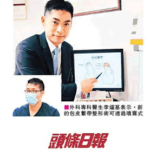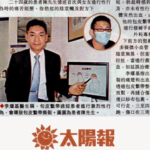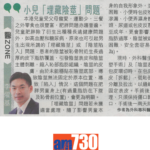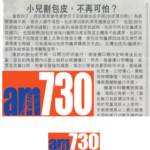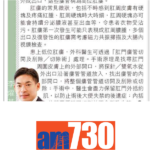What is thyroid gland? What are the common thyroid diseases?
Thyroid Hormone Imbalance
Hyperthyroidism
Hyperthyroidism is a disease caused by excess thyroid hormones (T3) and (T4) in the body. Hyperthyroidism patients’ blood tests usually show: high Free T4 value, high Free T3 value, and low TSH value. If a goiter/nodule produces too much T3 and T4, it can cause the following symptoms:
- Weight loss despite good appetite and eating a lot
- Increased sweating
- Hand tremor
- Nervousness
- Rapid or irregular heartbeat
- Weakness
- Muscle wasting
- Periodic paralysis (after high starch diet)
Hypothyroidism
Hypothyroidism is a disease caused by low levels of thyroxine (T3) and (T4) in the body. The incidence of hypothyroidism is 1.5%~2% in women and 0.2% in men, and the incidence increases with age. Hypothyroidism patients’ blood tests usually show: low Free T4 value, low Free T3 value, and high TSH value. If your blood has too low T3 and T4, it can cause the following symptoms:
- Dry skin
- Cold symptoms, fatigue and weakness
- Decreased memory, depressed mood, forgetfulness
- Weight gain, edema
- Afraid of cold
- Slow heart rate
- Hair loss
- Difficulty in breathing
- Hoarseness of voice
- Constipation
(2)Thyroid Swelling (Goiter) and Thyroid Nodules
A goiter is a diffuse swelling of the thyroid gland. A thyroid nodule can be solid, liquid, or mixed (solid + liquid) complex nodules inside the thyroid gland. A multinodular goiter is an enlarged thyroid with multiple nodules inside.
There are 4 situations in which thyroid swelling/nodules are found:
- Discovered by patients, relatives or friends, nurses, or doctors.
- Some large goiters/nodules can press on the trachea or esophagus, causing difficulty in breathing or swallowing.
- Discovered during a scan performed for other health reasons.
- Certain thyroid nodules or goiters produce too much thyroid hormone, causing hyperthyroidism symptoms.
Most of the slow-growing small thyroid nodules or cysts (<2cm) cause no signs or symptoms.
Goiter or thyroid nodule is caused by an abnormal growth of thyroid tissue.
Reasons for Thyroid Nodules/Swellings
- Thyroid adenoma: A benign overgrowth of normal thyroid tissue is called a thyroid adenoma. Its cause is unclear and it is not a cancer. Most adenomas require no treatment unless they cause compression on surrounding structures, such as the trachea or esophagus, causing symptoms. Some thyroid adenomas produce excessive T3 & T4 and cause hyperthyroidism, in which case treatment is also needed.
- Thyroid cyst: A fluid-filled cavity inside the thyroid, most commonly resulting from thyroid adenoma degeneration. Solid components are often mixed with fluid in thyroid cysts. Cysts are usually benign, but they occasionally contain cancer cells. Thyroid hemorrhagic cyst is mostly a benign condition. Rarely, thyroid cancer bleeds and forms a thyroid hemorrhagic cyst. Sudden acute onset hemorrhage or hemorrhagic infarction of a solid thyroid nodule can result in a predominantly cystic and painful neck mass. Acute onset hemorrhagic cysts containing 1 ml to 2 ml of blood, despite their small size, may be associated with considerable neck discomfort and dysphagia. The treatment should be ultrasound-guided aspiration, and the aspirated fluid should be sent for cytology examination. If the thyroid hemorrhagic cyst recurs after aspiration, surgery is indicated. If thyroid cancer cells are found in the aspirated fluid, surgery is indicated.
- Graves’ disease (Toxic diffuse goiter): Graves’ disease is a type of diffuse thyroid swelling with hyperthyroidism due to the overproduction of auto-antibodies against the thyroid-stimulating hormone (TSH) receptor on the follicular cells. These antibodies mimic the effects of TSH and cause overproduction and release of thyroid hormones, increasing the thyroid cells' number and thyroid size.
- Chronic inflammation of the thyroid: Hashimoto's disease or Hashimoto’s thyroiditis, a thyroid disorder, can cause thyroid inflammation, hyperthyroidism, and diffusely enlarged thyroid or enlarged nodules. This is often associated with initial hyperthyroidism and later on hypothyroidism.
- Multinodular goiter: The term multinodular goiter is used to describe the enlargement of the thyroid gland because of multiple thyroid nodules. It can be caused by iodine deficiency or other thyroid disorders. A multinodular goiter contains multiple cystic or solid nodules within the goiter, and its cause is unclear. The chance of the nodules containing cancer cells is low.
- Thyroglossal cyst: During fetal development, the thyroid tissue travels downwards from the posterior base of the tongue to the lower anterior neck. Thyroglossal cysts are an upper central neck mass or lump, which develops from cells and tissues left over along the tract where the thyroid tissue descends. Thyroglossal cysts can be complicated by infection and fistulation but rarely contain thyroid cancer.
- Thyroid cancers: The chance that a thyroid nodule is thyroid cancer is small. However, if a nodule is large, hard, and causes hoarseness of voice, pain, and discomfort, these may be clinical features of thyroid cancer. Please see your general surgeon to assess you as soon as possible.
(3)Thyroid Cancers
In 2020, there were 978 new cases of thyroid cancer, accounting for 2.9% of all new cancer cases in Hong Kong. The crude annual incidence rate of cancer per 100,000 Hong Kong population was 13. Women have a higher chance of getting the cancer, and the female to male ratio was about 3.8 to 1.
Types of Primary Thyroid Cancers
- Papillary thyroid cancer (~80% of all thyroid cancers): Papillary thyroid cancer develops from follicular cells and usually grows slowly. It is the most common type of thyroid cancer and is typically found in one lobe. About 10% to 20% of papillary thyroid cancer appears in both lobes at the same time or later in the course of the disease. It is a differentiated thyroid cancer, meaning the tumor looks similar to normal thyroid tissue under the microscope. Papillary thyroid cancer can often spread to lymph nodes but is usually curable.
- Follicular thyroid cancer (~10% of all thyroid cancers): Follicular thyroid cancer also develops from follicular cells and usually grows slowly. It is also a differentiated thyroid cancer but is far less common than papillary thyroid cancer. Follicular thyroid cancer rarely spreads to lymph nodes and is usually curable. Follicular thyroid cancer and papillary thyroid cancer are the most common differentiated thyroid cancers. They are very often curable, especially when found early and in people younger than 50. Together, follicular and papillary thyroid cancers make up about 95% of all thyroid cancer.
- Oncocytic cell carcinoma (~3% of all thyroid cancers): Previously called Hurthle cell cancer or Hurthle cell carcinoma, this cancer arises from a certain type of follicular cell. Oncocytic cell cancers are much more likely to spread to lymph nodes than other follicular thyroid cancers.
- Medullary thyroid cancer (MTC) (~3% of all thyroid cancers): MTC develops in the C cells and is sometimes the result of a genetic syndrome called multiple endocrine neoplasia type 2 (MEN2). This tumor has very little, if any, similarity to normal thyroid tissue. MTC can often be controlled if it is diagnosed early and treated before it spreads to other parts of the body. Other endocrine glands will need further imaging studies for the possibility of developing multiple endocrine tumors. About 25% of all MTC is familial, meaning family members of the patient will have a possibility of a similar diagnosis. The RET proto-oncogene test can confirm if family members also have familial MEN2.
- Anaplastic thyroid cancer (~1% of all thyroid cancers): This is a fast-growing, poorly differentiated thyroid cancer that may start from differentiated thyroid cancer or a benign thyroid tumor. This type of thyroid cancer grows very fast and is more difficult to treat successfully.
(4)Diagnosis
Surgeons will obtain a complete medical history from you and perform a thorough clinical examination, especially focusing on the thyroid, neck lymph nodes, and clinical thyroid hormone status (e.g., heart rate, hand tremor, reflexes).
Surgeons may perform the following tests for you:
- Blood tests for thyroid (e.g., TSH, FT4, FT3, and anti-thyroid antibodies)
- Ultrasound scan of the thyroid and neck region
- CT scan / MRI scan of the neck
- Radioactive thyroid scan
- PET CT scan
(5)Treatment of different thyroid diseases
The treatment of each thyroid disease depends on (1) different nature of the thyroid swellings or nodules and (2) thyroid function status.
(5.1) Treatment for Hyperthyroidism:
- Medicine: oral anti-thyroid drugs (e.g., carbimazole, propylthiouracil)
- Radioactive iodine
- Thyroid surgery
(5.2) Treatment for Hypothyroidism:
- Medicine: levothyroxine
(5.3) Treatment for Benign Thyroid Nodules:
If an ultrasound scan and cytology show that a thyroid nodule is benign and not cancer, then the options are:
- Close monitoring: If a biopsy shows that your thyroid nodule is benign, your doctor may recommend close observation (from every few months to yearly) of your thyroid with serial ultrasound scans to evaluate changes in the size of the thyroid nodule/swelling. If the thyroid nodule becomes larger, another ultrasound-guided aspiration cytology may be needed. Please consult your doctor for advice.
- Thyroid surgery: This may be needed when benign thyroid nodules are large, compressing the surrounding tissue or structure, and causing discomfort in breathing and swallowing. Thyroid nodules diagnosed as inconclusive or suspicious by ultrasound-guided fine-needle aspiration cytology also require surgical resection so that a pathologist can examine the specimen and confirm the final diagnosis. Please consult your doctor for advice.
- Radiofrequency ablation (RFA) thyroid nodule surgery: This is a minimally invasive method to treat benign thyroid nodules. Its main purpose is to shrink benign thyroid nodules. It is not suitable for the treatment of thyroid cancer. Please consult your doctor for advice.
(5.4) Treatment of Thyroid Nodules/Swelling Causing Hyperthyroidism:
If the thyroid nodules/swellings produce too much thyroid hormone, causing hyperthyroidism, there are 3 treatment options:
- Antithyroid medications: Oral antithyroid medications (such as carbimazole or propylthiouracil) can be used to reduce thyroid hormone production and control hyperthyroidism symptoms in patients with hyperthyroidism. Treatment is usually long-term and generally has good results and is well tolerated by most patients. Antithyroid drugs can rarely cause serious side effects in a patient's liver function and blood cells. Please consult your doctor for advice.
- Thyroid surgery: If the thyroid gland produces too much thyroid hormone, treatment is simply surgical removal of the diseased thyroid nodule or partial thyroidectomy. If the patient has diffuse toxic goiter (Graves’ disease) or toxic multinodular goiter, the treatment options are subtotal thyroidectomy or total thyroidectomy. Please consult your doctor for advice.
- Radioactive iodine (RAI): Take a capsule or liquid of radioactive iodine by mouth. The radioactive iodine will be absorbed from the gastrointestinal tract, enter the bloodstream, and be absorbed by thyroid cells. Thyroid cells will be gradually killed over two to three months. The swelling of the thyroid gland will shrink and the signs and symptoms of hyperthyroidism will subside. Years after radioactive iodine treatment, patients will become hypothyroid and require lifelong thyroid hormone replacement therapy. Recent studies in the United States have shown an increased incidence and mortality from breast and gastric cancer years after radioactive iodine treatment. Please understand RAI thoroughly before use. Please consult your doctor for advice.
(5.5) Treatment of Thyroid Cancers:
Treatment for thyroid cancer usually involves surgery. Different surgeries for thyroid cancers are:
- Hemithyroidectomy (removal of half of the thyroid gland)
- Total thyroidectomy (removal of all thyroid gland)
- Central lymph node dissection surgery
- Neck lymph node dissection surgery
The risks of thyroid cancer surgeries are low, but there is a small chance of damage to the recurrent laryngeal nerve (which affects control of the vocal cords) and damage to the parathyroid glands (four tiny glands located on the back of the thyroid that control calcium levels in the body). After total thyroidectomy surgery, you will need to take life-long levothyroxine therapy to provide thyroid hormone to the body. Please consult your doctor for advice.
Adjuvant Radioactive Iodine:
After surgeries for thyroid cancers, some patients may require radioactive iodine therapy. Take capsules or liquids of radioactive iodine orally. Radioactive iodine will be absorbed by the gastrointestinal tract, enter the bloodstream, and be absorbed by thyroid gland cancer cells, gradually killing thyroid cancer cells. Please consult your doctor for advice.
Alcohol Ablation:
Another option for treating some small cancerous nodules is alcohol ablation. The technique involves injecting a small amount of alcohol into the thyroid cancer. The alcohol kills the cancer cells. Alcohol ablation usually requires multiple treatments and is often reserved for patients who are not candidates for surgery. Please consult your doctor for advice.
(6)Thyroid Hemorrhagic Cyst
Thyroid cyst is a fluid-filled cavity or pocket inside the thyroid. A thyroid hemorrhagic cyst is a special kind of thyroid cyst that occurs after bleeding or tissue infarction. Thyroid hemorrhagic cysts are mostly benign; rarely, thyroid cancer bleeds and forms a thyroid hemorrhagic cyst.
Symptoms
Sudden acute onset (<24hr) of hemorrhage or hemorrhagic infarction of a solid thyroid nodule can result in a predominantly cystic and painful neck mass. Even small-sized hemorrhagic cysts with only 1 mL to 2 mL of acute bleeding may be associated with considerable neck discomfort and dysphagia.
Subacute onset (1 - 7 days) of hemorrhage or hemorrhagic infarction of a solid thyroid nodule may create thyroid hemorrhagic cysts (size 3 – 5 cm). Patients may feel neck discomfort, neck pain, neck swelling. Some may feel discomfort in breathing and swallowing.
Slow-growing large hemorrhagic cysts (>5 cm) may rarely occur. It may cause trachea compression (difficulty in breathing) and esophagus compression (difficulty in swallowing). If there is an acute bleeding in a slow-growing large hemorrhagic cyst, it may lead to asphyxia and death. If you have difficulty in breathing, please call 999 for emergency ambulance and medical service.
Investigation
Ultrasound scan, CT scan, and MRI scan of the thyroid can confirm the diagnosis of a thyroid hemorrhagic cyst.
Treatment
The treatment should be ultrasound-guided needle aspiration, and the aspirated fluid should be sent for cytology examination. If the thyroid hemorrhagic cyst recurs after aspiration, surgery is indicated. If the needle aspirated fluid contains cancer cells, surgery is indicated. Hemithyroidectomy is the usual procedure for this condition. Please consult your doctor for advice.
(7)Thyroglossal cyst
Thyroglossal cyst is also called thyroglossal duct cyst. During fetal development, the thyroid tissue travels downwards from the base of the tongue to the lower anterior neck. Thyroglossal cysts are central anterior upper neck masses or lumps that develop from cells and tissues left over along the tract where the thyroid tissue descends. Thyroglossal cysts can be complicated by infection, abscess formation, and fistulation, but they rarely contain thyroid cancer.
Symptoms
Thyroglossal cyst usually presents as a slow-growing central anterior upper neck lump with increasing discomfort. Infection sometimes occurs, causing sharp pain, redness, and abscess formation. The abscess may rupture and eventually form a fistula, with on and off discharge of blood, mucus, or pus.
Diagnosis
CT scan or MRI scan of the neck is usually required to assess the extent of the disease before surgery.
Treatment
The Sistrunk operation is the main procedure for thyroglossal cysts. The incision is placed in the skin crease over the lesion. The thyroglossal cyst, its upward extension, and part of the hyoid bone are usually excised at the same time. Please consult your doctor for advice.




